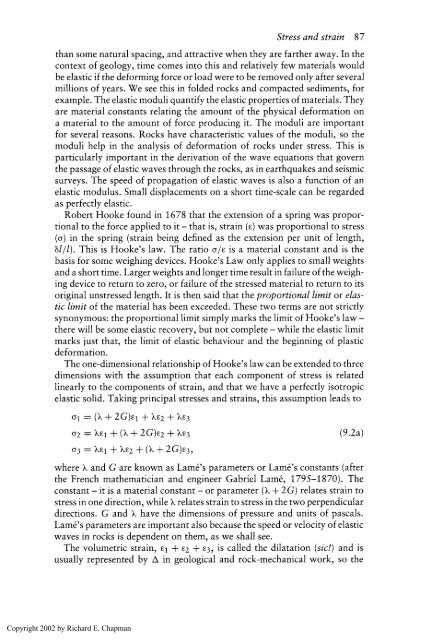Physics for Geologists, Second edition
Physics for Geologists, Second edition
Physics for Geologists, Second edition
You also want an ePaper? Increase the reach of your titles
YUMPU automatically turns print PDFs into web optimized ePapers that Google loves.
Stress and strain 87<br />
than some natural spacing, and attractive when they are farther away. In the<br />
context of geology, time comes into this and relatively few materials would<br />
be elastic if the de<strong>for</strong>ming <strong>for</strong>ce or load were to be removed only after several<br />
millions of years. We see this in folded rocks and compacted sediments, <strong>for</strong><br />
example. The elastic moduli quantify the elastic properties of materials. They<br />
are material constants relating the amount of the physical de<strong>for</strong>mation on<br />
a material to the amount of <strong>for</strong>ce producing it. The moduli are important<br />
<strong>for</strong> several reasons. Rocks have characteristic values of the moduli, so the<br />
moduli help in the analysis of de<strong>for</strong>mation of rocks under stress. This is<br />
particularly important in the derivation of the wave equations that govern<br />
the passage of elastic waves through the rocks, as in earthquakes and seismic<br />
surveys. The speed of propagation of elastic waves is also a function of an<br />
elastic modulus. Small displacements on a short time-scale can be regarded<br />
as perfectly elastic.<br />
Robert Hooke found in 1678 that the extension of a spring was propor-<br />
tional to the <strong>for</strong>ce applied to it - that is, strain ( E) was proportional to stress<br />
(o) in the spring (strain being defined as the extension per unit of length,<br />
8111). This is Hooke's law. The ratio U/E is a material constant and is the<br />
basis <strong>for</strong> some weighing devices. Hooke's Law only applies to small weights<br />
and a short time. Larger weights and longer time result in failure of the weigh-<br />
ing device to return to zero, or failure of the stressed material to return to its<br />
original unstressed length. It is then said that the proportional limit or elas-<br />
tic limit of the material has been exceeded. These two terms are not strictly<br />
synonymous: the proportional limit simply marks the limit of Hooke's law -<br />
there will be some elastic recovery, but not complete - while the elastic limit<br />
marks just that, the limit of elastic behaviour and the beginning of plastic<br />
de<strong>for</strong>mation.<br />
The one-dimensional relationship of Hooke's law can be extended to three<br />
dimensions with the assumption that each component of stress is related<br />
linearly to the components of strain, and that we have a perfectly isotropic<br />
elastic solid. Taking principal stresses and strains, this assumption leads to<br />
where h and G are known as Lamt's parameters or Lamt's constants (after<br />
the French mathematician and engineer Gabriel Lamt, 1795-1870). The<br />
constant - it is a material constant - or parameter (h + 2G) relates strain to<br />
stress in one direction, while X relates strain to stress in the two perpendicular<br />
directions. G and h have the dimensions of pressure and units of pascals.<br />
Lamt's parameters are important also because the speed or velocity of elastic<br />
waves in rocks is dependent on them, as we shall see.<br />
The volumetric strain, el + ~2 + ~ 3 is , called the dilatation (sic!) and is<br />
usually represented by A in geological and rock-mechanical work, so the<br />
Copyright 2002 by Richard E. Chapman






